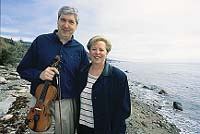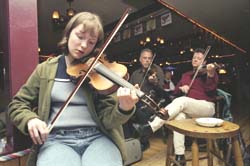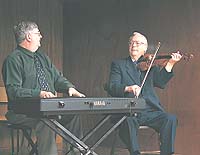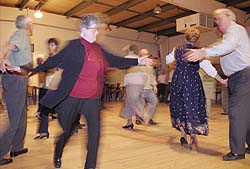 |
 |
| current issue |  |
past issues |  |
send a letter/news |  |
address update |  |
advertise |  |
about us |  |
alumni home |
Short Features
Along the Ceilidh TrailStomping out the beat with Cape Brenton's hard-driving fiddlers.
by Anne Downey '95G
Burt Feintuch began playing the fiddle in graduate school at the University of Pennsylvania as a diversion from his course work on folklore and folk life. However, the diversion soon became a distraction, and there were days when he would send his wife off to work with the key to his fiddle case so he could finish writing his dissertation. He can't remember when he first heard the distinctive fiddle music of Cape Breton, Nova Scotia, but he took his first trip to the island in 1996, and the music has been a personal passion and a focus of his academic work ever since that visit.
 A new Smithsonian Folkways CD features the music of some of Cape Brenton's best musicians, including fiddler Kinnon Beaton and pianist Betty Beaton. - by Gary Samson |
Feintuch, an English professor and director of the Center for the Humanities at UNH, spent a couple of weeks on Cape Breton in the Summer of 2000, recording fiddle music along Route 19, which has been dubbed the "Ceilidh Trail." (Ceilidh, pronounced kay-lee, is a Gaelic word for a neighborly gathering, although it has increasingly come to mean a musical event.) He has collected the best of those recordings on "The Heart of Cape Breton: Fiddle Music Recorded Live Along the Ceilidh Trail," a CD released last summer by Smithsonian Folkways Recordings. "This is not the pristine sound of studio recordings," he writes in the liner notes. "It's the sound of real people playing music hard. ... There's a drive and an energy in these recordings that comes from playing for people, not for microphones. It's the sound of the music when it's at home."
Because of geographic isolation, the fiddle music of Cape Breton, and more specifically of Inverness County, is remarkably similar to the music played by the Scottish immigrants who settled there in the early 1800s. "Cape Bretoners talk about their music representing a purer and older Scottish style and repertoire than the music played these days in Scotland," Feintuch says.
 Gillian Head, with UNH professor Burt Feintuch and Brenda Stubbert in the background, displays the distinctive Cape Brenton style at a music session at Rollie's Wharf in North Syndey. - by Gary Samson |
The music includes a number of genres: strathspeys, reels, jigs, airs, marches, hornpipes, clogs and others. There is a strong emphasis on being able to "drive 'er," or play hard-driving dance music with a strong focus on rhythm. The fiddler's feet are part of the performance: No one plays without stomping on the floor in time with the tune.
 The legendary Buddy MacMaster, fiddle, and Joey Beaton, keyboard, on stage at the hall in Glencoe Mills. - by Gary Samson |
The Cape Breton bowing technique is distinctive as well. "There is a lot of what some fiddlers call 'dirt,'" Feintuch explains. "It's not a pure, sweet sound but more of a complex sound, with double-stops and drones, bow cuts, many sorts of trills, rasps and other techniques." Up until the early 1960s, Inverness County was largely Gaelic-speaking, and many believe that the "dirt" in the music replicates the guttural sounds of the language.
 Dancing is a regular activity o Nova Scotia's Cape Brenton. - by [%byline%] |
It's hard to overestimate the role that music plays in Cape Breton culture. As Feintuch notes, it is simply everywhere. During the summer, there are regular weekly dances, as well as others that crop up as part of community festivals and other events. Gift shops, hardware stores, grocery stores and other shops sell tapes and CDs of local musicians. "If you go into the bank in Inverness, you're likely to hear fiddle music in the background, where you'd ordinarily expect Muzak," Feintuch says. "If you pick up the Inverness Oran, the local weekly newspaper, there's more coverage of local music than sports."
Feintuch believes that "the music represents for many a kind of cultural continuity." Cape Breton is not an easy place to make a living. The main industries of the past--steel and coal--are now gone, and the fishing industry is changing. Many people who grew up on the island have moved away, and few of the local musicians can support themselves just by playing music. Despite these hardships--or perhaps because of them--the music endures. And now, thanks to Feintuch's CD, it can be enjoyed by a wider circle of listeners. ~
Editor's note: Excerpts from the CD "The Heart of Cape Breton" are available on the Smithsonian Folkways Recordings Web site. To listen to the "New Haven Reel," "The Devil in the Kitchen," "Gallagher's Jig" and more, visit the Web site, http://www.folkways.si.edu/index.html
Easy to print version
blog comments powered by Disqus

